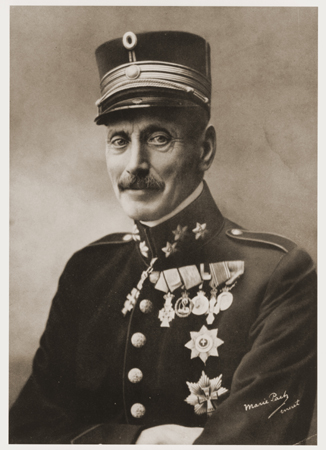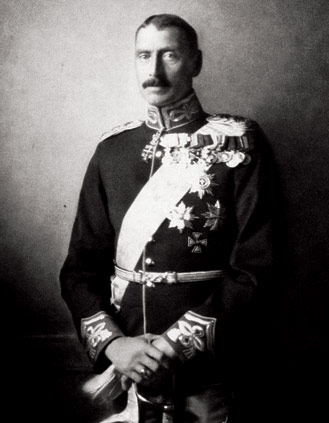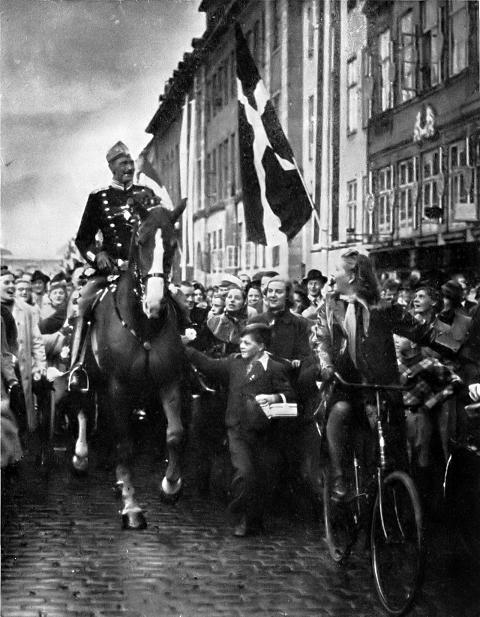<Back to Index>
- Neurologist Ugo Cerletti, 1877
- Poet Thomas Stearns Eliot, 1888
- King of Denmark Christian X, 1870



Christian X (Christian Carl Frederik Albert Alexander Vilhelm) (26 September 1870 – 20 April 1947) was King of Denmark from 1912 to 1947 and the only official King of Iceland (as Kristján X), between 1918 and 1944. He was born at Charlottenlund Palace near Copenhagen.
He was the oldest son and child of King Frederick VIII of Denmark and his wife, Princess Louise, only surviving child of King Charles XV of Sweden. Among his siblings were King Haakon VII of Norway. Christian married Princess Alexandrine, Duchess of Mecklenburg - Schwerin in Cannes on 26 April 1898; she eventually became his Queen Consort. They had two children: Prince Frederick (1899–1972), later King Frederick IX of Denmark and Prince Knud (1900–1976), later Knud, Hereditary Prince of Denmark.
Being
something of an authoritarian and a ruler who strongly stressed the
importance of royal dignity and power in an age of growing democracy,
Christian X did not seem fit for popularity. However, a reign spanning
two world wars and the role he was believed to have played under Nazi rule made him one of the most popular Danish monarchs of modern times. Christian X was the 1,100th Knight of the Order of the Golden Fleece in Spain, the 849th Knight of the Order of the Garter in 1914 and the 265th Grand Cross of the Order of the Tower and Sword. In
April 1920, Christian instigated the Easter Crisis, perhaps the most
decisive event in the evolution of the Danish monarchy in the 20th
century. The immediate cause was a conflict between the king and the
cabinet over the reunification with Denmark of Schleswig, a former Danish fiefdom, which had been lost to Prussia during the Second War of Schleswig. Danish claims to the region persisted to the end of World War I, at which time the defeat of the Germans made it possible to resolve the dispute. According to the terms of the Treaty of Versailles, the disposition of Schleswig was to be determined by two plebiscites: one in Northern Schleswig (today Denmark's South Jutland County), the other in Central Schleswig (today part of the German state of Schleswig-Holstein).
No plebiscite was planned for Southern Schleswig, as it was dominated
by an ethnic German majority and, in accordance with prevailing
sentiment of the times, remained part of the post-war German state. In
Northern Schleswig, 75% voted for reunification with Denmark and 25%
for remaining with Germany. In this vote, the entire region was
considered to be an indivisible unit, and the entire region was awarded
to Denmark. In Central Schleswig, the situation was reversed with 80%
voting for Germany and 20% for Denmark. In this vote, each municipality
decided its own future, and German majorities prevailed everywhere. In
light of these results, the government of Prime Minister Carl Theodor Zahle determined that reunification with Northern Schleswig could go forward, while
Central Schleswig would remain under German control. Many Danish nationalists felt that at least the city of Flensburg should
be returned to Denmark regardless of the plebiscite's results, due to
the sizeable Danish minority there and a general desire to see Germany
permanently weakened in the future. Christian agreed with these
sentiments, and ordered Prime Minister Zahle to include Flensburg in
the re-unification process. As Denmark had been operating as a parliamentary democracy since the Cabinet of Deuntzer in
1901, Zahle felt he was under no obligation to comply. He refused the
order and resigned several days later after a heated exchange with the
king. Subsequently,
Christian dismissed the rest of the cabinet and replaced it with a de
facto conservative care-taker cabinet. The dismissal caused
demonstrations and an almost revolutionary atmosphere in Denmark, and
for several days the future of the monarchy seemed very much in doubt.
In light of this, negotiations were opened between the king and members
of the Social Democrats.
Faced with the potential overthrow of the Danish crown, Christian stood
down and dismissed his own government, installing a compromise cabinet
until elections could be held later that year. To
this day, this was the last time when a sitting Danish monarch
attempted to take political action without the full support of
parliament; following the crisis, Christian accepted his drastically
reduced role as symbolic head of state. In contrast to his brother, King Haakon VII of Norway, and Queen Wilhelmina of the Netherlands, who went into exile during the Nazi occupation of their countries, Christian X remained in his capital throughout the occupation of Denmark,
being to the Danish people a visible symbol of the national cause.
Though his official speeches were often little more than an echoing of
the government's official policy of cooperation with the occupying
forces, this did not prevent him from being seen as a man of "mental
resistance". In spite of his age and the precarious situation, he took
a daily ride on his horse, "Jubilee" through his city — not accompanied
by a groom, let alone by a guard. While acknowledging greetings from
the Danish population, he would studiously ignore the punctilious
salutes of German military personnel. In 1942, Adolf Hitler sent the king a long telegram congratulating him on his 72nd birthday. The king's reply telegram was a mere, Meinen besten Dank. Chr. Rex (English: My best thanks, King Chr.).
This perceived (and no doubt deliberate) slight greatly outraged Hitler
and he immediately recalled his ambassador from Copenhagen and expelled
the Danish ambassador from Germany. German pressure also resulted in
the dismissal of the government led by Vilhelm Buhl and its replacement with a new cabinet led by non-party member and veteran diplomat Erik Scavenius, who the Germans expected would be more cooperative. After a fall with his horse on 19 October 1942,
he was more or less an invalid for the rest of his reign. The role he
had played in creating the Easter Crisis of 1920, had greatly reduced
his popularity, but his obvious disdain for the German Wehrmacht, daily rides and the Telegram Crisis had once again made him popular to the point of being a beloved national symbol. In the early 1980s, the International Herald Tribune ran a full-page advertisement for a war-era commemorative photograph of Christian X on his horse "Jubilee", wearing a Star of David on his sleeve. The image echoed a popular tale that claimed the king wore the symbol as a sign of support for and solidarity with Danish Jews, who suffered from Nazi persecution during the occupation. (The story had become well-known partially through its retelling in Leon Uris's 1958 novel of the founding of Israel, Exodus.)
This attribution of support is apocryphal, however, as the yellow badge
was never introduced in Denmark. It originated in a conversation
between the king and his minister of finance, Vilhelm Buhl,
during which Christian remarked that if the German administration tried
to introduce the symbol of the Star of David in Denmark, "perhaps then
we should all wear it." King
Christian used to ride through the streets of Copenhagen unaccompanied
while the people stood and waved to him. One apocryphal story relates
that one day, a German soldier remarked to a young boy that he found it
odd that the king would ride with no bodyguard. The boy reportedly
replied, "All of Denmark is his bodyguard." This story was recounted in Lois Lowry's popular children's book Number the Stars. The contemporary patriotic song "Der rider en Konge" (There Rides a King)
centres on the king's rides. In this song, the narrator replies to a
foreigner's inquiry about the king's lack of a guard that "he is our
freest man" and that the king isn't shielded by physical force but that
"hearts guard the king of Denmark". Another
popular legend is the one of the flag on Amalienborg. The Germans
wouldn't let the king fly the Danish flag at his castle and told him
that if it wasn't taken down the Germans would send a soldier to take
it down. The king replied that if that was the case he would send a
Danish soldier to raise it again. The Germans replied that they would
shoot that soldier and the king replied, "that Danish soldier will be
me". And throughout the war the Danish flag flew at Amalienborg. A
popular way for Danes to display patriotism and silent resistance to
the German occupation was wearing a small square button with the Danish
flag and the crowned insignia of the king. This symbol was called the Kongemærket (King's Emblem pin). On his death in Amalienborg Palace, Copenhagen, in 1947, Christian X was interred along other members of the Danish royal family in Roskilde Cathedral near
Copenhagen. In recognition of his symbolic significance during World
War II, a cloth armband of the type worn by members of the Danish resistance movement was placed on his coffin at castrum doloris.